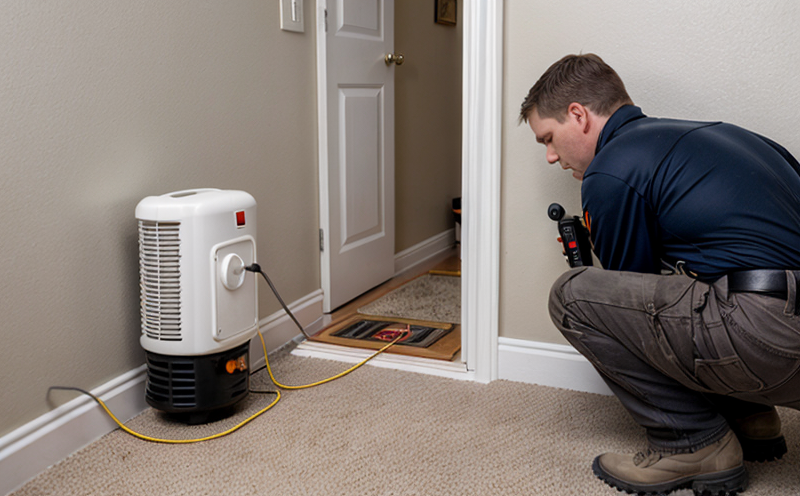Heat Detector Inspection
The inspection of heat detectors is a critical aspect of fire safety and protection systems. Heat detectors are designed to respond to changes in temperature, triggering an alarm when the ambient temperature exceeds a predetermined threshold. This response mechanism ensures early detection of potential fire hazards, thereby providing essential time for evacuation and firefighting efforts.
Heat detectors operate based on thermal sensors that monitor increases in temperature. These sensors can be either fixed or automatic, depending on the application. The primary function of heat detectors is to detect a rise in ambient temperature indicative of a fire event. They are commonly used in industrial settings where early warning systems can prevent significant damage and loss.
For effective functioning, proper installation and regular maintenance are crucial. This includes periodic calibration checks to ensure the detector responds accurately within specified limits. The standard operating range for most heat detectors is between 54°C and 93°C (129°F to 200°F), although some models can operate in wider temperature ranges.
The inspection process involves several key steps: visual inspection, functional testing, and documentation of findings. During the visual inspection, any visible damage or signs of wear are noted. Functional testing checks whether the detector operates correctly under simulated conditions. This includes checking for proper activation and deactivation times, as well as ensuring that the detector sends accurate signals to connected systems.
International standards such as ISO 17463-2:2009 provide guidelines for the testing and inspection of heat detectors. Compliance with these standards ensures consistency and reliability across different regions. Proper adherence to these standards is essential for maintaining safety and regulatory compliance in fire protection systems.
Industry Applications
The application of heat detector inspections spans various industries where fire risks are significant. In industrial facilities, such as manufacturing plants and warehouses, the presence of large volumes of flammable materials increases the likelihood of fire incidents. Heat detectors play a vital role in these environments by providing immediate alerts that can help prevent catastrophic events.
In commercial buildings, heat detectors ensure the safety of occupants during emergencies. Hotels, office complexes, and retail spaces all benefit from early detection systems to safeguard lives and property. Educational institutions also rely on robust fire protection measures to protect students, staff, and visitors.
The transportation sector includes various modes such as airports, train stations, and bus terminals where large numbers of people transit through high-risk areas daily. Implementing heat detectors in these locations enhances safety by providing timely warnings during potential incidents. Additionally, the healthcare industry relies on comprehensive fire protection strategies to ensure patient care continuity without disruptions due to emergencies.
Heat detectors are also used in residential settings, particularly for older homes or those with specific vulnerabilities like electrical systems prone to overloading. By installing heat detectors, homeowners can enhance their home's safety profile against accidental fires caused by various factors including cooking mishaps or heating malfunctions.
International Acceptance and Recognition
- ISO 17463-2:2009: This international standard specifies the requirements for testing, inspection, and maintenance of heat detectors in fire protection systems.
- ASTM E1825-16: American Society for Testing and Materials standard which provides guidance on the performance criteria for thermal detectors used in fire detection systems.
- EN 54:2020: European Standard that sets out the requirements for the design, manufacture, installation, testing, commissioning, maintenance, operation, and decommissioning of products intended to be used in fire safety systems.
- IEC 6889-1:2017: International Electrotechnical Commission standard covering the requirements for heat detectors used in automatic fire detection systems.
- NFPA 72:2020: National Fire Protection Association's standard on signaling devices, including provisions related to the installation and testing of heat detectors.
- BS 5839-6:2014: British Standard that provides recommendations for fire detection systems design, installation, and maintenance practices.
The acceptance of these standards ensures compatibility and interoperability among different types of fire protection equipment across various countries. Compliance with these internationally recognized norms helps organizations meet local regulations while ensuring global consistency in product performance.
Environmental and Sustainability Contributions
The inspection and maintenance of heat detectors contribute positively to environmental sustainability efforts by reducing the frequency and severity of fires, which can lead to significant ecological impacts. Effective fire protection minimizes property damage, thereby conserving resources that would otherwise be wasted in rebuilding or replacing structures.
By preventing fires through early detection, businesses and institutions can also reduce their carbon footprint associated with emergency response activities such as firefighting operations. Additionally, the use of advanced heat detectors equipped with energy-efficient features helps to minimize power consumption during normal operations while ensuring optimal performance when required.
The integration of heat detectors into smart building systems further enhances sustainability by allowing real-time monitoring and adjustment based on actual conditions. This approach optimizes resource usage according to occupancy levels and environmental factors, leading to more efficient operation overall.
Furthermore, regular inspections contribute to extending the lifespan of fire protection equipment, which reduces waste generation from premature disposal due to suboptimal performance or lack of maintenance. Properly maintained heat detectors not only enhance safety but also promote responsible resource management practices within organizations.





